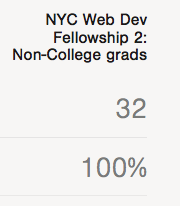Graduation rates in the United States are notorious for being abysmally low. Nearly half of students who enroll in college never end up finishing, which puts us at the lowest college completion rate in the developed world. This is a huge problem for many reasons — from the amount of debt people accrue to the importance employers place on that little piece of paper. Since its inception in 2012, Flatiron School has sought to flip traditional education on its head and find new ways for students to seek out success and outcomes. In a show of faith to that, we released our second annual jobs report this week. As we spoke about in a previous post, this is part of a greater pledge to bring transparency to programming immersives. This report matters for many reasons. Not only does it prove what's possible with a different model of higher ed, it also reveals all kinds of opportunities for other educators to help their students get meaningful careers after graduation. In sum: There is so much possibility and potential to be gleaned from these statistics. Here's a look at the numbers between graduation rates and average income between Flatiron School and other New York and American colleges.
Flatiron School's Graduation Rates

Last year, nearly every single one of our students graduated from our programs. This statistic is especially poignant when it comes to our fellowship grads. Let's zoom in on this one in particular:

100% of non-college grads who attended this rigorous program graduated. That entailed several months of living and breathing code, often giving up a stable income and basic comforts, to make that dream a reality. That should make everyone pause for a second and think about the potential outcomes-based education has for students all over the world. Granted, the sheer number of students who attended Flatiron School's immersives in the past year (246) are much smaller than all the students in various New York colleges combined. However, it's still important to examine the difference in graduation rates between places like Flatiron School and other higher education systems in New York.
New York College Graduation Rates
Infographics and information provided by The Chronicle of Higher Education. 4-YEAR NEW YORK PUBLIC COLLEGES

New York public colleges had an average 38.7% graduation rate within four years of schooling, with 20.5% more graduating within two more years, which is about a 1 in 3 success rate.2-YEAR NEW YORK PUBLIC COLLEGES

Despite the shorter time frame, two year colleges actually had a worse rate, with only 20.6% of students graduating — that means 4 in 5 students never completed their two-year degree.4-YEAR NEW YORK PRIVATE COLLEGES

And finally, the stats for private New York private colleges were admittedly better, but still with only a little over half of students graduating on time and 13.1% more completing two years after. It's obvious that in many ways that stacking these stats is comparing apples to oranges. Flatiron School's immersives last between 3-5 months, though they are very time intensive and require 150 hours of pre-work prior to admissions. Two year and four year programs take, well, two and four years respectively. But looking at these models, it's obvious that something needs to change in traditional higher education to achieve a higher bar of success. Another metric to compare is after graduation — how much money traditional college grads are making versus how much money Flatiron School grads are making. Let's take a look:
Flatiron School Average Graduate Income:
$74,447
*This statistic entails the average income of students who graduated and accepted a full-time position in the technology field.
United States Average College Graduate Income:
$45,478
Broken down further by profession:

Infographic provided by Time.com
Obviously, it's time for higher education to get better. It's time for something to change. Not everyone is destined to become a professional software developer, but the United States has projected 1,240,600 people will need to fill those roles within seven years. Continuing to scale programming immersives, both in person and online, may very well be the key to making higher education work again.




